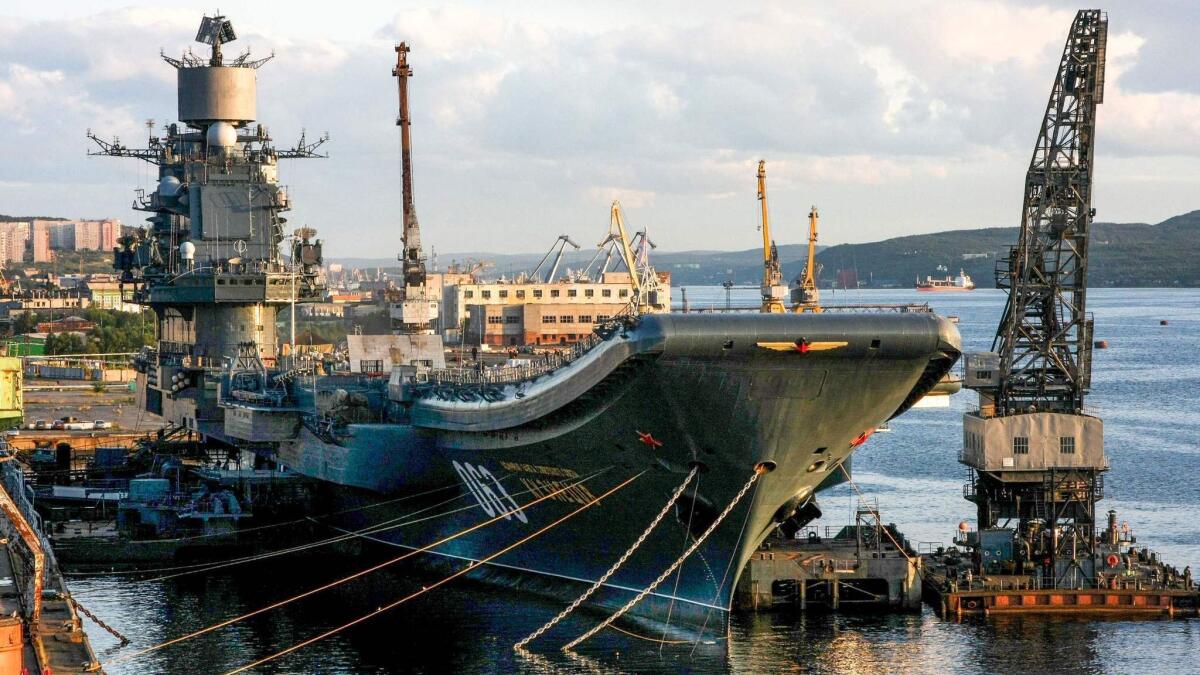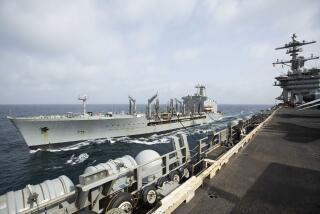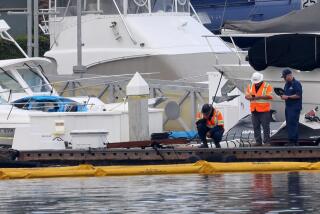Russia’s only aircraft carrier, in port for upgrades, is damaged in dock accident

- Share via
Reporting from MOSCOW — Russia’s only aircraft carrier, the Admiral Kuznetsov, was damaged Tuesday when a floating dry dock berthing the massive vessel suddenly took on water and sank in the frigid waters of Russia’s Arctic region. Four yard workers were injured and one was said to be missing in the accident, which caused a crane to topple onto the carrier.
The flagship of the Russian navy, the Admiral Kuznetsov was undergoing extensive renovations aboard the floating workshop when the accident occurred. The dock was apparently tied into the local electrical grid when a sudden power outage led to its ballast tanks taking on water, sending both the dock and the Admiral Kuznetsov into a dramatic roll.
“We are still assessing the scale of the damage,” Alexsey Rakhmanov, head of Russia’s United Shipbuilding Corp., told Russian news agencies on Tuesday. “A crane fell onto the flight deck from a height of 15 meters [about 49 feet], and it is understood that there is a hole in the hull and on the flight deck,” he said, adding that the damage was not critical and could easily be repaired.
The incident has bolstered the aircraft carrier’s reputation as Russia’s unluckiest ship. When dispatched on a flag-waving cruise to Syria’s Mediterranean Coast in 2016, it lost two of its planes -- a MiG-29 and an Su-33 -- when its arrestor wire, which snags airplanes landing on the flight deck, snapped and sent them tumbling into the sea.
When deployed on far-reaching patrols, the Admiral Kuznetsov has been escorted by a tugboat, the Nikolai Chiker. On more than one occasion, it has towed the aircraft carrier to safety when its diesel propulsion system repeatedly failed. The ship also was the scene of an engine room fire in which a crew member was killed and an oil slick formed off the coast of Ireland.
The loss of the PD-50 dry dock -- Russia’s largest -- also underscored the poor safety record of Russian shipyards in recent years. Several ships have been damaged by fires during repair or construction, including the loss of the missile cruiser Kerch during repairs in the Crimean port of Sevastopol in 2014.
“The greatest danger a Russian ship faces is not from adversaries at sea,” said Michael Kofman, an expert on the Russian navy at the CNA think tank in Virginia, “but from Russia’s own shipbuilding and overhaul facilities, where many a ship has been lost or damaged in such accidents over the years.”
Rakhmanov and other sources quoted by the Russian media suggested that the aircraft carrier was preparing to leave the dock when the incident took place. But it had been mounted atop the floating dock for an expensive and lengthy overhaul that began this summer and there was no indication that it was ready to move.
Izvestia newspaper, citing unidentified yard sources, reported that only a skeleton crew was aboard that saved the ship from going down with the dock, though it took on several thousand tons of water.
Kremlin spokesman Dmitry Peskov told reporters in Moscow that the Kremlin was deferring to the United Shipbuilding Corp. for information on the incident. Russia’s Investigative Committee, a law enforcement body, has opened a criminal case into the cause of the dock’s sinking.
The loss of the dry dock could have a significant impact on the Russian navy’s ongoing modernization efforts. Rakhmanov said that “this dock is used not only for Admiral Kuznetsov, but also for other [big] ships, so other repair work this year will be stopped.”
The dock was built by Sweden for the former Soviet Union, and though there are other large docks and yards in the Russian Arctic and Far East, they lack the width and infrastructure to house a ship like the Admiral Kuznetsov -- about 1,000 feet long and 236 feet wide. The aircraft carrier itself was originally built in Ukraine.
The other dry docks are already tied up with renovation projects including the refit of a Soviet-era nuclear battle cruiser, a cornerstone of Russian naval modernization efforts known as the Admiral Nakhimov.
The dock is owned by Russia’s state oil monopoly Rosneft, and Rakhmanov says his company will have to sue Rosneft to cover any damages incurred. The accident, said analyst Kofman, “will not only delay Kuznetsov’s modernization, but the loss of PD-50 will inevitably affect the overhaul, repair and refit tempo of the entire Russian Northern Fleet.”
Bodner is a special correspondent.
UPDATES:
10:40 a.m.: This article has been updated with staff reporting about the incident and background on the carrier.
This article was originally published at 9:30 a.m.
More to Read
Sign up for Essential California
The most important California stories and recommendations in your inbox every morning.
You may occasionally receive promotional content from the Los Angeles Times.










